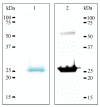Benzothiazolyl Ureas are Low Micromolar and Uncompetitive Inhibitors of 17β-HSD10 with Implications to Alzheimer's Disease Treatment
- PMID: 32192199
- PMCID: PMC7139388
- DOI: 10.3390/ijms21062059
Benzothiazolyl Ureas are Low Micromolar and Uncompetitive Inhibitors of 17β-HSD10 with Implications to Alzheimer's Disease Treatment
Abstract
Human 17β-hydroxysteroid dehydrogenase type 10 is a multifunctional protein involved in many enzymatic and structural processes within mitochondria. This enzyme was suggested to be involved in several neurological diseases, e.g., mental retardation, Parkinson's disease, or Alzheimer's disease, in which it was shown to interact with the amyloid-beta peptide. We prepared approximately 60 new compounds based on a benzothiazolyl scaffold and evaluated their inhibitory ability and mechanism of action. The most potent inhibitors contained 3-chloro and 4-hydroxy substitution on the phenyl ring moiety, a small substituent at position 6 on the benzothiazole moiety, and the two moieties were connected via a urea linker (4at, 4bb, and 4bg). These compounds exhibited IC50 values of 1-2 μM and showed an uncompetitive mechanism of action with respect to the substrate, acetoacetyl-CoA. These uncompetitive benzothiazolyl inhibitors of 17β-hydroxysteroid dehydrogenase type 10 are promising compounds for potential drugs for neurodegenerative diseases that warrant further research and development.
Keywords: 17β-hydroxysteroid dehydrogenase type 10; ABAD; Alzheimer’s disease; benzothiazole; inhibitor; neurodegeneration.
Conflict of interest statement
The authors declare no conflict of interest.
Figures













Similar articles
-
Design, synthesis and in vitro evaluation of benzothiazole-based ureas as potential ABAD/17β-HSD10 modulators for Alzheimer's disease treatment.Bioorg Med Chem Lett. 2016 Aug 1;26(15):3675-8. doi: 10.1016/j.bmcl.2016.05.087. Epub 2016 May 30. Bioorg Med Chem Lett. 2016. PMID: 27287370
-
Synthesis and evaluation of frentizole-based indolyl thiourea analogues as MAO/ABAD inhibitors for Alzheimer's disease treatment.Bioorg Med Chem. 2017 Feb 1;25(3):1143-1152. doi: 10.1016/j.bmc.2016.12.029. Epub 2016 Dec 27. Bioorg Med Chem. 2017. PMID: 28082069
-
Novel Benzothiazole-based Ureas as 17β-HSD10 Inhibitors, A Potential Alzheimer's Disease Treatment.Molecules. 2019 Jul 29;24(15):2757. doi: 10.3390/molecules24152757. Molecules. 2019. PMID: 31362457 Free PMC article.
-
Infantile Neurodegeneration Results from Mutants of 17β-Hydroxysteroid Dehydrogenase Type 10 Rather Than Aβ-Binding Alcohol Dehydrogenase.Int J Mol Sci. 2023 May 9;24(10):8487. doi: 10.3390/ijms24108487. Int J Mol Sci. 2023. PMID: 37239833 Free PMC article. Review.
-
Friend or enemy? Review of 17β-HSD10 and its role in human health or disease.J Neurochem. 2020 Nov;155(3):231-249. doi: 10.1111/jnc.15027. Epub 2020 May 23. J Neurochem. 2020. PMID: 32306391 Review.
Cited by
-
Nanomolar Benzothiazole-Based Inhibitors of 17β-HSD10 with Cellular Bioactivity.ACS Med Chem Lett. 2023 Nov 10;14(12):1724-1732. doi: 10.1021/acsmedchemlett.3c00355. eCollection 2023 Dec 14. ACS Med Chem Lett. 2023. PMID: 38116418 Free PMC article.
-
High-Throughput Screening of Potent Drug-like Molecules Targeting 17β-HSD10 for the Treatment of Alzheimer's Disease and Cancer.ACS Chem Biol. 2025 Jul 18;20(7):1544-1559. doi: 10.1021/acschembio.5c00110. Epub 2025 Jun 18. ACS Chem Biol. 2025. PMID: 40530895 Free PMC article.
-
Design, Synthesis and Biological Activities of (Thio)Urea Benzothiazole Derivatives.Int J Mol Sci. 2023 May 30;24(11):9488. doi: 10.3390/ijms24119488. Int J Mol Sci. 2023. PMID: 37298442 Free PMC article. Review.
-
Benzothiazole-Containing Analogues of Triclocarban with Potent Antibacterial Activity.Antibiotics (Basel). 2021 Jul 1;10(7):803. doi: 10.3390/antibiotics10070803. Antibiotics (Basel). 2021. PMID: 34356724 Free PMC article.
-
C-3 Steroidal Hemiesters as Inhibitors of 17β-Hydroxysteroid Dehydrogenase Type 10.ACS Omega. 2024 Feb 28;9(10):12116-12124. doi: 10.1021/acsomega.3c10148. eCollection 2024 Mar 12. ACS Omega. 2024. PMID: 38496976 Free PMC article.
References
-
- He X.Y., Merz G., Mehta P., Schulz H., Yang S.Y. Human brain short chain L-3-hydroxyacyl coenzyme A dehydrogenase is a single-domain multifunctional enzyme. Characterization of a novel 17beta-hydroxysteroid dehydrogenase. J. Biol. Chem. 1999;274:15014–15019. doi: 10.1074/jbc.274.21.15014. - DOI - PubMed
-
- Zschocke J., Ruiter J.P., Brand J., Lindner M., Hoffmann G.F., Wanders R.J., Mayatepek E. Progressive infantile neurodegeneration caused by 2-methyl-3-hydroxybutyryl-CoA dehydrogenase deficiency: A novel inborn error of branched-chain fatty acid and isoleucine metabolism. Pediatr. Res. 2000;48:852–855. doi: 10.1203/00006450-200012000-00025. - DOI - PubMed
MeSH terms
Substances
Grants and funding
LinkOut - more resources
Full Text Sources
Miscellaneous

